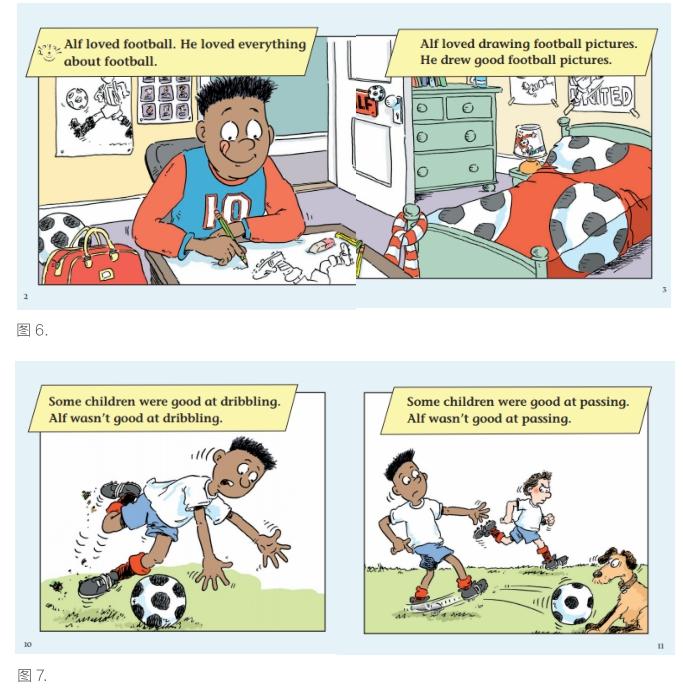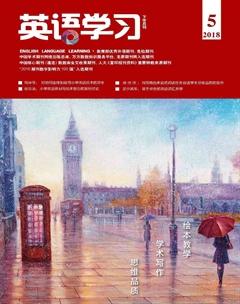小学英语教材与绘本整合的案例讨论
侯云洁



摘 要:小学英语教材的体裁单一性特点不利于小学生阅读素养的发展,由于绘本故事图文并茂、主题丰富、体裁多样、语言真实,小学阶段将英语教材与绘本整合,能有效促进小学生的阅读兴趣与阅读动机,还能提升审美能力和多元价值观。由于小学英语课时不够,与教材融合的方法主要是主题衔接、内容结合,课堂的实践模式表现为融合式或者衔接式两种方式。低年级段采用图片环游法,高年级段采用片段阅读法。只要把握好时间分配与语言聚焦问题,教材与绘本整合的教学就能发挥其重要作用,促进小学生的英语阅读能力提升。
关键词:教材与绘本整合;图片环游;片段阅读
教材与绘本整合的必要性
英语教材是语言学习的文本,是基于《义务教育英语课程标准(2011年版)》( 以下简称《课标》),具有不同主题和语言知识结构的规范文本。英语教材的内容和主题虽然丰富多样,但从体裁丰富性、语言容量度、故事趣味性来说还不够充分,小学生的阅读能力需要通过课内阅读和课外拓展来提高阅读理解能力。根据《课标》“英语教学的特点之一就是要使学生尽可能通过不同渠道、以不同形式来学习真实、鲜活、实用的英语,直接体验语言和运用语言。在英语教学中,除了合理有效地使用教科书以外,还应该积极开发和利用学习的各种资源,为学生提供丰富、真实的学习语言和使用语言的机会。”目前绘本阅读是契合小学生年龄阶段,包含真实、鲜活的语言,能拓展小学英语语言学习的最佳资源。
绘本起源于17世纪的日本和欧洲,中国近代也有小人书等类似于绘本的书籍。目前全世界针对儿童的绘本图书种类繁多,故事意义丰富,人文价值突出。英文绘本语言简练,能有效地配合小学英语学习。除此之外,小学英语绘本还有其他几项功能:第一,从绘本的设计来看,具有审美和情感体验的功能,图文并茂,生动活泼,充满想象力和创造力。第二,能够发展小学生的多元思维与批判思维能力。绘本作者无论从主题、故事情节都具有不同思维和创作手法,因此对于小学生的思维品质培养具有促进作用。第三,绘本的学习还能促进学生良好的阅读体验,由于绘本短小精炼,内容思想有趣,能吸引学生主动去阅读,容易形成阅读成就感。第四,绘本的应用还能提升小学生的阅读兴趣和动机,从而辅助甚至强化对课本内容的学习。从课外阅读的研究来看,主题兴趣决定了学生的阅读动机。因此,在教学中融入不同主题的绘本,并与课本主题适当衔接,能够激发小学生的阅读兴趣,有效培养小学生的阅读能力。第五,经典的绘本故事内容还能培养学生良好的道德情感和人文价值观。故事是人类最常见的叙事方式,通过有趣的故事传递重要的人文价值观,让读者体验不同文化,形成多元思维,理解世界上不同的价值观,逐步发展跨文化的交际能力和奠定良好的人文素养。
那么,绘本与教材如何做到整合与对接呢?小学英语课时不足一直是很多学校面临的问题,在很多公立学校,一周只有1~3节英语课,教师很难有效安排好教材与绘本的整合教学。因此,笔者认为,实施的途径主要是融合式和衔接式。融合式就是在一节课内将绘本内容与课本内容进行融合,通常课堂时间总量为课本内容一半,绘本内容一半,但也可以根据课本与绘本内容进行适当的时间调整。主要原则是“基于主题课内整合学习、基于兴趣课外广泛阅读。”下面笔者分别以小学三年级与六年级为例,谈一谈小学英语教材与绘本整合的两种方式:融合式与衔接式及两种教学方法、图片环游法与片段阅读法。
教材与绘本整合的“融合式”案例
· 低年级段教材与绘本融合案例 (“融合式”对接整合、图片环游法)
以人教版《PEP小学英语》三年级上册Unit 4 “We love animals”为例,本课书学习的句型较为简单,学生学习到很多关于动物的单词:
Whats that?—A bear?
No! Its a panda (tiger, monkey, bird, duck, rabbit, pig).
作为初学者或者已经有初步英语基础的学生可以阅读绘本《动物派对》(The Animal Party)(见下页图1),学生学习了动物的名称后,拓展绘本中的主句型“Can you …like…?”以及“come to my party”。以下是绘本内容:
“Can you bark like a dog? Yes, I can. Woof! Woof! Good! Come to my party. ”
“Can you quack like a duck? Yes, Quack! Quack! Good! Come to the party.”
“Can you hoot like an owl? Too Whit! Too Whoo! You can come to the party too.”
“Can you moo like a cow? Moo Mooo! Moooooo! Come to my party today.”
“Can you baa like sheep? Baa! You can come too.”
“Can you roar like dinosaurs? Roar! Roar! Roar! You can all come to my party.”
“Too Whit! Too Whoo! Woof! Baa! Quack! Roar! Moo!”
“We can all talk to the animals!”
在這个绘本故事中,学生只学习过课文中的dog,duck两个生词,其他动物的词分别是owl,cow,sheep,dinosaurs。因此增加这本绘本的阅读实际上是增加了四个动物的单词,并且要学会两句话“Can you … like…?”以及“come to my party”。“融合式”的实践方式是教师在教授课本上句型“Whats this / that?”以及动物的单词20分钟后,进入故事学习,直接用课文句型“Whats this / that?”穿插衔接故事。绘本教学方式使用图片环游法。
T: (教师在PPT上展示农场和奶牛的叫声,并故意走很远做出听动物声音的样子)Whats that? This time, guess: what animal would Jennifer like to invite? Moo! Mooo! Moooooo!
Ss: Cow!
T: Now class, can you moo like a cow?
Ss: Moo! Mooo!
T: Ask and invite friends again in groups. “Can you moo like a cow?”Group 1 asks Group 2…
【设计意图】
在图片环游过程中,有的图片花费时间多一些,有的则很快能完成练习。这幅图片的操练方式用组与组之间对话,因为“cow”这个词比较简单易学。
Step 6:图片环游(5)
T: (老师请一位同学戴上绵羊头饰)Whats this? Sheep! Can you baa like a sheep?Baa, follow me, class!
Ss: Can you baa like a sheep? Baa.
T: Zhu Yilin, Can you baa like a sheep?
S (Zhu Yilin): Yes. Baaa.
T: You can come to my party. Lin Jun, can you baa like a sheep?
S (Lin Jun): Yes. Baaa.
T: Good; then come to my party.
【設计意图】
这一部分采用师生对话方式,以尽快结束对话练习,留出充分的时间练习下面的新生词,拓展学习内容。图片环游可以让教师选择合适的时间对每幅图进行详略得当的讲解。
Step 7:图片环游(6)
T: (老师放了一段恐龙的叫声,然后假装露出害怕的样子) Whats that? Guess, Jennifer wants to invite…
Ss: 恐龙。
T: You are right. (接着老师把图片在PPT上呈现出来) Dinosaurs. Read after me.
Ss: Dinosaurs.
T: Dinosaurs roar.(老师继续播放刚才的声音,一遍遍重复roar)
Ss: Dinosaurs roar.
【设计意图】
这次呈现的单词是生词,需要学生反复读练,因此,教师要把dinosaur这个词练习很多遍,然后把roar 放在语境中单独练习,以让学生获得习得的效果。
Step 8:图片环游 (7)
T: (教师在刚才的教学环节中已经把头饰分发给六个组不同的同学,因此在动物宴会上,人与动物分别用动物语言交流)Now, please stand up and talk to each other like the animals.
Ss: Woof! Woof! Baa! Baa! Quack! Quack! Moo! Moo! Roar! Roar! Too Whit! Too whoo!
【设计意图】
让同学们模拟真实动物派对场景,互相用动物语言对话,此时完成了一本绘本的阅读,学生也在玩乐和动物叫声中感受了人与动物友好相处的情景(见图4)。
Step 9:朗读绘本
T: (教师播放录音)This time you can read the picture book aloud by following the tape.
T: (教师让学生自己读)Please read to each other loudly in pairs.
【设计意图】
通过大声朗读,再次熟悉所学绘本内容,感受了动物派对友好和谐、有趣生动的场面。此时图片环游式阅读就完成了。
以上是低年级段教材与绘本融合的一种教学模式,此时学生语言基础较为薄弱,所以采用表演式朗读为主,因为学生英语刚刚起步或者词汇量有限,教师可以根据学生基础对图片环游中的某些图片详细处理,或者简略处理,以确保在有限时间内阅读和欣赏完一本绘本。教师在最后重点强调主句型的同时,也就结束了绘本的学习。在此案例中,课内课本句型“Whats this/ that?”与课外绘本句型“Can you bark (talk) like a dog(ducks, cows)?”… 进行了无痕的对接整合,这就是融合型教学。
教材与绘本整合的“衔接式”案例
·高年级段教材与绘本融合案例 (“衔接式”对接整合、片段阅读法)
下面是高年级段教材与绘本融合的绘本教学模式,使用“片段阅读”的绘本阅读方法。由于绘本长度较长,故事性强, 教师可以在绘本的重要情节片段加入语言训练和思维发散的训练。如人教版《PEP小学英语》英语六年级上册Unit 4 “I have a pen pal.”中的Read and write部分是关于club(俱乐部)的,尤其提到体育俱乐部。课文如下:
Shall we dance?
There is a dance class on Sunday at 1 p.m. I like dancing and I need a partner. Call Amy: 334 5567 Goal! Goal! Goal!


What do you do on Sundays? Join our football club! See you on the playground! john@pep.com.cn
Lets read together!
What is your hobby? Do you like reading? I have great books. We can share!
Call Mike: 443 5678 Science Club, Your club!
Do you want to learn about robots? Come to science room? Meet Robin. He teaches students to make robots. Robin@ pep.com.cn
適合对接的绘本是《球迷阿尔夫》(Alf Saves the Day)。绘本的内容如下(见图5):
Alf Saves the Day
Alf loved football. He loved everything about football. Alf loved drawing football pictures. He drew good football pictures. Alf loved writing football stories. He was good at football stories. Great! Alf loved watching football on television. He cheered and cheered. Alf loved going to football matches. There were lots of people and everyone cheered. Alf was a big football fan. At school, lots of children played football. Lots of boys and lots of girls played. Alf really, really wanted to be a football star. But he wasnt good at football. Some children were good at dribbling. Alf wasnt good at dribbling. Some children were good at passing. Alf wasnt good at passing. Alf wasnt good at shooting. He wasnt good at heading. Alf was just no good at football. He felt very sad. The football coach picked five children for one team. He picked five children for the other team. Alf went to watch the football match. Suddenly, Alf shouted, “look out!”Alf jumped up in the air…and make a very good save! All the children cheered. The football player cheered. The football coach cheered. The dinner lady cheered.
Good save! Good save! Good save!
“What a good save, Alf!” everyone said.
The football coach said, “Alf, come with me.”
Alf stood in the goal and the coach took a shot. It was a good shot, but Alf saved it. Alf saved the next shot, too. And the next one. He saved every shot! All the children cheered. Alf was a very good goalkeeper. He was good at playing football after all!
Step 1:导入
T: What do you know about clubs? Let me tell you a story about football clubs. There is a boy called Alf. He is at the same age as you. He loves football so much. But he cant join school football team. Can you guess why?
S1: Maybe he just likes watching football, but cant play well.
S2: There are enough players in the team.
S3: He doesnt have time to join the training.
S4: He has to go back home to do homework.
T: Very good guesses! Do you know what happened to them? Lets read about his stories.
【设计意图】
教师导入绘本阅读时提出问题让学生的思维活跃起来,促成阅读好奇心和阅读动机。这对于绘本阅读来说是重要的开端(见图6)。
Step 2:片段阅读(1)
T: Now please read from Page 2 to Page 7. Alf loved football very much. Please tell me how he likes football.
S1: He loved drawing football pictures.
S2: He loved writing football stories.
S3: he loved watching football on television.
S4: He loved going to football matches.
T: Then what do you love? Football, basketball…
S5: I love playing basketball.
T: Then do you love drawing basketball pictures and writing basketball stories?
S5: No, I dont.
T: Then do you love watching basketball on television and going to basketball matches?
S5: Yes, I do.
T: So you see, Alf is crazy about football. But can he join the club? Before we know what is happening to Alf, lets learn some techniques about football.
【設计意图】
片段阅读有利于学生在把握故事脉络与结构过程中学习语言知识。学生通过回答问题,理解了主人公Alf对足球的热爱,同时学生也练习了“love doing something”的句型。老师还可以及时地把问题拉近学生自身,然后再巧妙地联结到第二个片段。
Step 3:片段阅读 (2)
1.词汇准备
T: In the football match, what techniques do you know?
学生用中文说:运球、传球、射球、顶球,教师顺势用英文说“dribbling, passing, shooting, heading”并把这些纸质图片贴在黑板上,接下来让学生用“be good at”说自己或者其他同学擅长做什么(见图7)。
S1: Im good at passing the ball.
S2: Shen Bin is good at dribbling.
S3: Li Meng is good at shooting.
S4: Im good at heading.
S5: Im not good at shooting.
【设计意图】
学生在讨论自己熟悉的运动中学习英文的表达,教师顺势让学生自己说是否擅长于这些技术。生词的引入显得自然、流畅,学生一边表达自我,一边学习短语。这样避免了阅读前生词介绍的不自然,也避免了打断阅读理解的思维逻辑,并能够在语境中学习和使用生词。
2. 提问引领
T: Now, please read from Page 8 to Page 13. What wasnt Alf good at?
S1: Alf wasnt good at dribbling.
S2: Alf wasnt good at passing.
S3: Alf wasnt good at shooting.
S4: Alf wasnt good at heading.
T: Yes! Alf was just no good at football. How did he feel?
Ss: He felt very sad.
T: I am no good at shooting, but good at heading, what about you? Now tell me what you are good at and what you are not good at?
S5: I am no good at dribbling, but I am good at passing.
S6: ...
【设计意图】
教师通过提问让学生用英语表述了一遍,既练习了生词,又理解了文本,教师还可以适当地衔接到学生自身的实际情况,让学生重复表达这些话语(见图8)。
3.推断交流
T: What will Alf do if he wants to join the club? Do you think he will give up?
S: He wont, because he likes football so much.
S: He will give up, because after all he wont be accepted by the club.
S: He can join the club, because he can do other things for the club.
T: For example…
S: For example, he can bring things to the club for the members.
【设计意图】
片段阅读的要领是用问题把每一个片段接续起来。教师通过与同学交流,让学生对故事情节充满了想象力和好奇心,然后再带着强烈的动机往下阅读。
Step 4:片段阅读 (3)
T: Ok, let me tell you. Something happened and it changed Alfs situation. Do you want to know?
Ss: Yes!
T: Read and tell me what happened to Alf.
T: Now read together!
Ss: (学生群读)Alf went to watch the football match. Suddenly, Alf shouted, “look out!” Alf jumped up in the air…and make a very good save! All the children cheered. The football player cheered. The football coach cheered. The dinner lady cheered.
“Good save! Good save! Good save!”
“What a good save, Alf!”everyone said.
T: So Alf might be good at some techniques? What is it?
S: It is shooting.
S: It is dribbling.
S: It is passing.
S: It is heading.
T: It is heading! You are right!
【设计意图】
片段阅读的另一要领就是教师对学生情感的引领,让学生边读、边思、边说,有助于深刻的理解故事,并从中习得语言(见图9、图10)。
Step 5. 片段閱读 (4)
T: Now, continue and finish reading Page 20 to Page 24, what does the coach do then? You can read aloud by yourself.
S: The coach teaches Alf how to head.
T: Now he is a good goalkeeper. Finally he was good at playing football. I feel happy for Alf. What about you? Do you feel happy?
Ss: Yes.
【设计意图】
片段阅读的实施方法就是多种阅读方法,例如默读、听读、演读、群读、对读和自读等,这些变换方式的阅读有助于学生在阅读中交流,在交流中理解,得到真正阅读的乐趣,同时还练习了语言(见图11)。
Step 6: 绘本阅读主旨讨论
T:So what do you get from the reading?
S1: Never give up.
S2: Keep loving football.
T: Yes.
S3: Keep working hard.
S4: Keep dreaming.
T: Yes! The one who can get the chance is the one who can keep trying. Do you and your friends have similar stories?
S5: I like football too, and I am good at shooting.
T: Oh, really? Can you say a few words about how you love it?
S5: I like football. I love watching football matches on television. I also love going to football matches. I can play football very well. I am not good at dribbling, passing, heading, but I am good at shooting. I feel happy when I play football.
T: Great class! I would like you to make a story like Shen Bin (S5). Or make another story about a ball lover.
S6: I have a friend and his name is Jim. He loves basketball very much. But he is no good for basketball. He wasnt good at dribbling, wasnt good at passing, wasnt good at shooting. He just loves watching basketball matches.
T: Thats also a good story. Now group work. Please write a story of someone in the sports clubs, using the sentence “love doing something” “be good at” “be not good at”.
【设计意图】
任何一个好的绘本故事都有文眼和人文思想,因此提问是为了让学生进行深度思考,发表自己观点。但教师还需要把文本拉近学生的生活,为故事语篇的再构提供思想和情感基础。学生在教师的引领下,说出和写出自己的故事。
Step 7:词句聚焦总结
T: So today we have learned a story about Alf who joins the football club through his hard work, and the spirit of never giving up. We also learned several words to talk about football and basketball techniques.
Football clubs, be good at, football / basketball Shooting,football/basketball dribbling,football / basketball passing,football / basketball heading.
Step 8:布置作業
T: Write a story about you or your friends in the sports club. Use what we have learned, or follow the model of Group 1 or 2. Any questions? Lets stop here. I will see you tomorrow.
结语
教材与绘本整合应注意几个问题:一是语言量的问题,对绘本的学习过程中,故事意义在前,词句聚焦在后,并且语言练习不宜过多,否则容易导致意义学习中断,故事趣味降低;二是课堂时间安排的问题,根据教学内容和学生的实际,教师可以尝试两种整合模式,一种是融合式,即教材学习与绘本学习各占一半时间,是一种无痕对接的方式,如本文中的第一个例子,另一种是衔接式,即根据学校实际状况,每周用一个课时,也可以每两周用一个课时来读一本绘本,主题的选择基于教材话题,是教材话题的延伸,如本文中的第二个例子; 三是绘本阅读应实施课内与课外的互动,做到课内指导,课外拓展,遵循“基于主题课内整合学习、基于兴趣课外广泛阅读”,真正发挥绘本阅读作为泛读课程的功能,通过扩大学生接触语言的量,以及体验绘本中真实、有趣的语言,发展小学生的阅读素养和语言能力。

